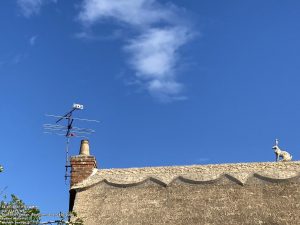
This was an opportunity that was too good to miss, this customer had only just had her thatch renewed and had decided to put a thatched hare on the roof. Indeed, the thatch was so new the scaffolding was still up and the thatchers had only finished working the day before! I like this one as not only is the hare a very handsome fellow, it’s quite close to home the beautiful North West Essex village of Radwinter. The lady customer told me that she had decided to have a hare on the roof because she frequently saw them playing and boxing in the field immediately opposite the cottage. Radwinter End is rather out in the sticks if anyone knows it, one road in and the same road out and miles and miles of farmland with not much in between.
Hares are rather fascinating animals, so here are some interesting facts about hares: Hares form part of the genus Lepus, the same family group as rabbits. Young hares are known as Leverets and the collective noun for a group of hares is a ‘drove’. Although, characteristically hares are a solitary animal or live in pairs; they live in a den formed on the ground which is called a ‘form’. A male hare was once called a Jack and a female a Jill. Mother hares have between 1 to 4 litters, usually three, a year, with one to four leverets per litter, with the Leverets being born from February to October. A new litter is conceived before the previous one has been born. Hares can run very fast reaching speeds of 45mph which is how fast these two on the roof are probably going! They also tend to run in straight lines, and if they are seen to turn whilst running it will normally be a right-angle turn.
Hare is a hare poem I found on the internet which I think is quite fitting for this blog:
Hares at Play by John Clare
The birds are gone to bed, the cows are still,
And sheep lie panting on each old mole-hill;
And underneath the willow’s gray-green bough,
Like toil a-resting, lies the fallow plough.
The timid hares throw daylight fears away
On the lane’s road to dust and dance and play,
Then dabble in the grain by naught deterred
To lick the dew-fall from the barley’s beard;
Then out they sturt again and round the hill
Like happy thoughts dance, squat, and loiter still,
Till milking maidens in the early morn
Jingle their yokes and sturt them in the corn;
Through well-known beaten paths each nimbling hare
Sturts quick as fear, and seeks its hidden lair.


 My name is Paddy McKeown, I am a retired police officer (Detective Sergeant – Metropolitan Police), turned chimney sweep. I have completed training with ‘The Guild of Master Chimney Sweeps’, and Rod Tech UK (Power Sweeping).
My name is Paddy McKeown, I am a retired police officer (Detective Sergeant – Metropolitan Police), turned chimney sweep. I have completed training with ‘The Guild of Master Chimney Sweeps’, and Rod Tech UK (Power Sweeping).




Comments are closed.